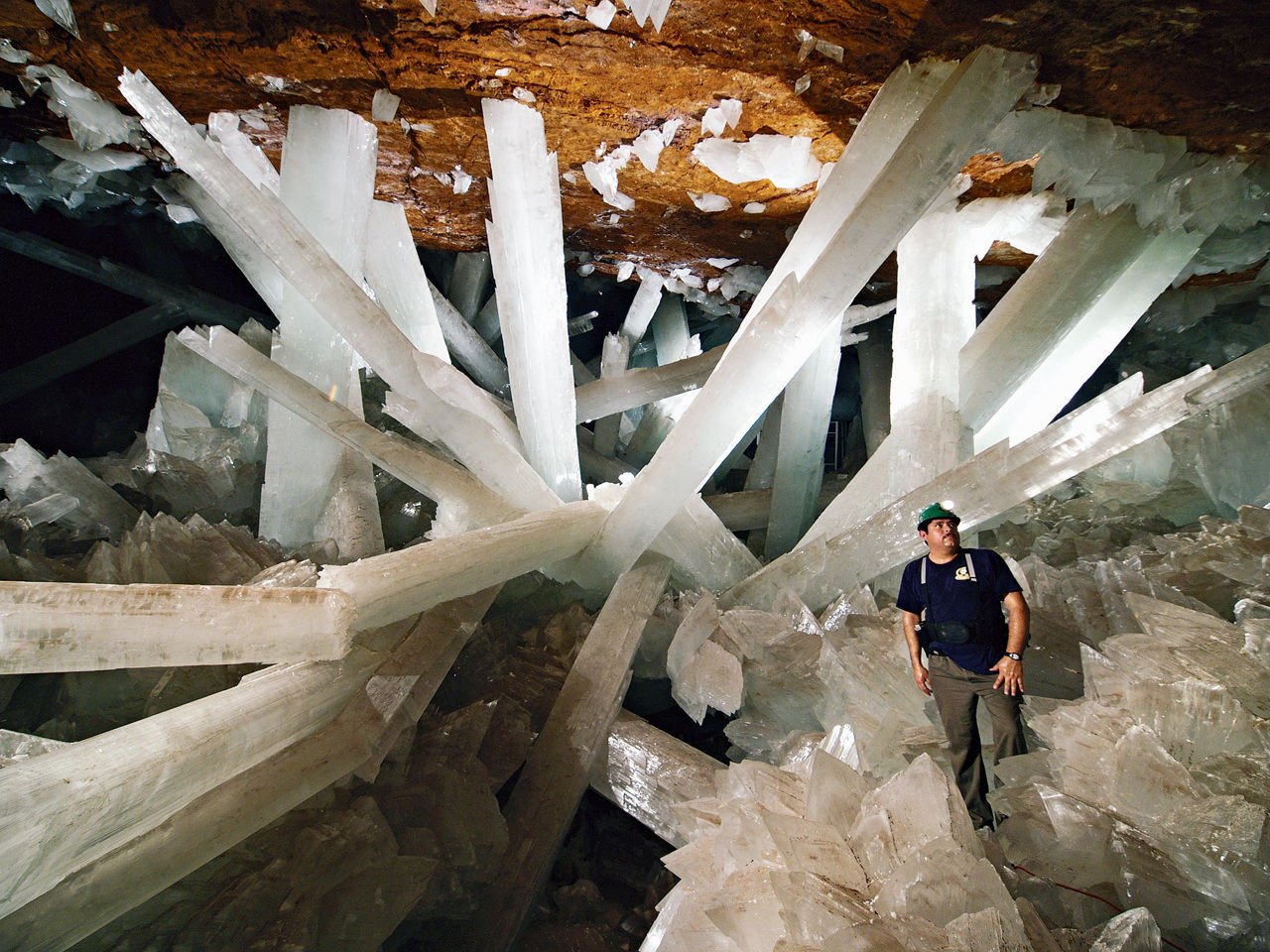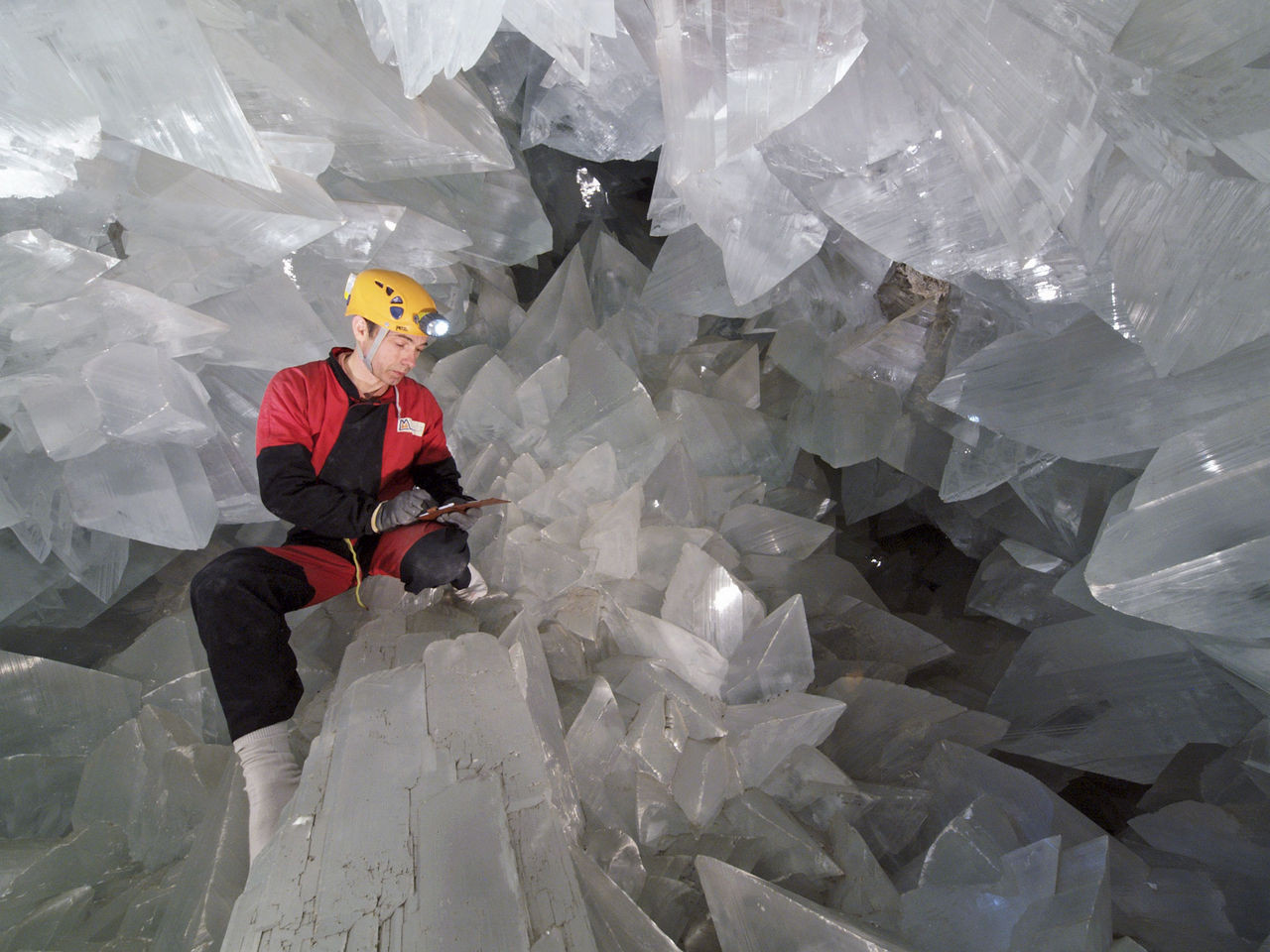Deep within the heart of Mexico, hidden beneath layers of rock and earth, lie some of the world’s most breathtaking natural wonders – the Mexican crystal caves. While often referred to as quartz caves in broader descriptions due to the crystalline nature of their formations, these subterranean realms hold secrets far more intricate and fascinating. Among these, the Cave of Crystals in Naica stands out as a testament to nature’s artistry, showcasing gigantic selenite gypsum crystals that defy imagination.
In the year 2000, miners in Naica, while excavating for new ore deposits, stumbled upon an awe-inspiring spectacle. A horseshoe-shaped cave, located deep under a mountain, was filled with colossal, milky-white crystals. These weren’t your typical quartz formations; instead, they were massive beams of gypsum, some stretching up to 12 meters in length and 1 meter in width, radiating in all directions from the cave’s limestone structure. This extraordinary find was christened the Cave of Crystals, a name that perfectly encapsulated its surreal beauty.
 Photgraph shows a person in the Cave of Crystals with giant white gypsum crystals criss-crossing behind him.
Photgraph shows a person in the Cave of Crystals with giant white gypsum crystals criss-crossing behind him.
Located 290 meters beneath a mountain rich in lead, zinc, and silver, the Cave of Crystals quickly became a magnet for researchers and scientists worldwide. The mining company Industrias Peñoles, responsible for the discovery, recognized the scientific significance of this subterranean chamber. The cave presented a unique opportunity to study crystal formation under extreme natural conditions, captivating experts with its rare beauty and scientific enigmas.
Among the early visitors was Juan Manuel García-Ruiz, a crystallographer from the University of Granada, Spain. For García-Ruiz, who had been cultivating crystals in labs since adolescence, witnessing the Naica crystals firsthand was a momentous occasion. He described his initial reaction as “euphoric,” a testament to the cave’s overwhelming impact on those who entered its crystalline embrace.
Over the subsequent years, researchers like García-Ruiz have ventured into the cave’s intensely hot and humid environment to unravel the mysteries of the crystals’ origin and growth. Nearly two decades later, many questions have been answered, shifting the focus towards the crucial task of protecting and preserving these natural treasures for generations to come. The challenge lies in navigating the ongoing mining operations and the natural forces within the mountain itself.
The Underground Flask: Genesis of Giant Crystals
Approximately 26 million years ago, the geological narrative of the Cave of Crystals began with a surge of magma pushing upwards through the Earth’s crust beneath what is now southeastern Chihuahua, Mexico. This magmatic activity led to the formation of a mountain near Naica and infused hot, mineral-rich waters into the caverns and fissures within the mountain’s limestone. It was within these mineral-laden waters that the giant crystals of Naica were conceived.
The cave’s environment was saturated with calcium sulfate-rich water. Calcium sulfate can crystallize into various minerals, but in the Naica caves, gypsum (CaSO4·2H2O), specifically the transparent, colorless variety known as selenite, emerged as the predominant mineral. This particular form of gypsum is responsible for the stunning clarity and size of the crystals.
 Image shows the crystal structure of gypsum.
Image shows the crystal structure of gypsum.
Alexander Van Driessche, a crystallographer from the National Center for Scientific Research’s Institute of Earth Science, who collaborated with García-Ruiz, explains the mineral stability zones. Anhydrite (CaSO4) is more stable at temperatures above 58 °C, while gypsum is more stable and less soluble below this threshold.
Initially, anhydrite deposits precipitated from the magma-heated waters. Over millennia, as the water gradually cooled below 58 °C, the anhydrite began to dissolve, providing the necessary calcium and sulfate for gypsum crystals to nucleate and grow. The slow dissolution of anhydrite maintained a slightly supersaturated solution, ideal for the gradual, monumental growth of gypsum crystals (Geology 2007, DOI: 10.1130/G23393A.1).
Crystal growth, whether in a laboratory or a natural cave, commences with nucleation. This involves the arrangement of molecular building blocks around a minuscule foundation, initiating the crystal’s expansion. In the Cave of Crystals, the low level of supersaturation favored slow nucleation but extensive crystal growth, allowing a select few crystals to reach gargantuan dimensions.
Van Driessche and his team further investigated gypsum nucleation in laboratory settings. Their findings revealed an unconventional nucleation process: gypsum crystals originate from nanoclusters of CaSO4, coalescing rather than forming from a traditional tiny crystal seed (Science 2012, DOI: 10.1126/science.1215648).
Understanding the fundamental processes of gypsum crystal formation has implications beyond the Naica caves. It can aid in mitigating mineral buildup in desalination plants and provide insights into gypsum formation on other planets like Mars. However, the researchers were not only intrigued by nucleation but also by the sheer size attained by the Naica crystals.
Infinitesimal Growth: Time and Temperature
The Cave of Crystals is not the sole gypsum crystal cave beneath the mountain near Naica; other chambers exist, permeated by the same mineral-rich waters. Yet, the crystals in these adjacent caves do not match the extraordinary size of those in the Cave of Crystals. Van Driessche and García-Ruiz discovered that in addition to the specific chemical conditions, a precisely slow cooling rate was crucial for the mammoth proportions of the crystals.
 Image shows a person in the narrow Cave of Swords with swordlike crystals covering the walls on both sides.
Image shows a person in the narrow Cave of Swords with swordlike crystals covering the walls on both sides.
The Cave of Swords, situated at a shallower depth of 120 meters, provides a contrasting example. Here, water temperatures cooled more rapidly than in the deeper Cave of Crystals. This faster cooling favored gypsum crystal nucleation over growth, resulting in a multitude of smaller, sword-like crystals covering the cave walls, reaching up to 2 meters in length. In the Cave of Crystals, the slower cooling rate meant fewer crystals nucleated, but they were granted the time and stability to grow to an enormous size. This difference highlights a classic example of the interplay between crystal nucleation and growth rates.
The prolonged period during which the water temperature in the Cave of Crystals remained within the transition zone between anhydrite and gypsum allowed for uninterrupted, imperceptible crystal growth over vast epochs. To determine the exact timescale, researchers meticulously measured crystal growth rates in the lab using samples from the Naica mine and its waters.
The layered structure of gypsum crystals, with water molecules sandwiched between calcium sulfate layers, facilitated these measurements. The weak hydrogen bonds between water layers allowed for easy flaking, providing pristine, flat surfaces for growth studies.
“When I entered the first time, after the first couple of minutes of stupor, I burst out laughing. I was euphoric.”
Juan Manuel García-Ruiz, crystallographer, University of Granada
By placing gypsum samples in mine water for 24–48 hours and measuring the increase in surface height using phase-shifting interferometry, a technique capable of detecting growth rates at the 10–5 nm/s scale, the team estimated the growth rates at temperatures between 54 and 58 °C. These measurements revealed an astonishingly slow growth rate. It would have taken nearly 1 million years for a 1-meter-thick crystal to form at 55 °C (Proc. Natl. Acad. Sci. U.S.A. 2011, DOI: 10.1073/pnas.1105233108). This equates to adding the thickness of a sheet of paper every 200 years, illustrating the incredibly protracted timescale of crystal formation in the Cave of Crystals.
Drained and Dangerous: Challenges of Preservation
Had the Cave of Crystals remained submerged, the crystals might have grown even larger. The current conditions, with a water temperature of approximately 55 °C, are still conducive to gypsum crystal formation and growth. However, mining operations in Naica have artificially lowered the water table to access more mineral deposits. While this drainage made the giant crystals accessible, it also created a harsh environment and posed risks to the crystals themselves.
Industrias Peñoles’s water pumping operations, equivalent to draining an Olympic-sized swimming pool every 40 minutes, exposed the caves to air and human access. Unlike the Cave of Swords, which suffered from crystal pilfering after its discovery in 1910, access to the Cave of Crystals has been carefully restricted to protect both the crystals and visitors.
The cave’s environment is extremely hostile to humans. Temperatures reach 50 °C with over 90% relative humidity, rendering sweating ineffective for cooling. Navigating the cave is also perilous, with researchers having to clamber over condensation-slick gypsum spears. The risk of getting lost or injured is significant, making rescue operations exceptionally challenging.
“I just want to see them once more.”
María Elena Montero-Cabrera, researcher, Center for Research in Advanced Materials
Due to these extreme conditions, researchers could only endure 10–15 minute shifts inside the cave. Access is controlled by sealed doors, isolating the cave and maintaining a more tolerable antechamber environment. Medical checks were mandatory before each entry to ensure visitors were fit to withstand the cave’s climate.
Beyond the human challenges, the drained environment presents risks to the crystals. The largest beams, weighing 40–50 metric tons, risk cracking under their own weight without water’s buoyancy. Gypsum’s softness (Mohs hardness of 2) means even foot traffic has visibly worn paths into the cave floor crystals.
To devise effective preservation strategies, researchers like Montero-Cabrera have studied the impact of the drained environment on the crystals. Laboratory experiments simulating gaseous environments revealed that the crystals face dehydration, with bassanite, a dehydrated form of calcium sulfate, detected on crystal surfaces (Cryst. Growth Des. 2018, DOI: 10.1021/acs.cgd.8b00583). This indicates a gradual change in crystal appearance over time, reinforcing that removing crystals from the cave is not a viable preservation method.
No Crystal Ball: An Uncertain Future
Research in the Cave of Crystals has slowed as key questions about its formation and growth have been addressed. Mining operations closed access to the cave around 2015 due to flooding exceeding pump capacity. While water levels have risen in the mine, the Cave of Crystals remains seemingly unaffected.
 Photo shows a person inside a cave containing large, clear gypsum crystals.
Photo shows a person inside a cave containing large, clear gypsum crystals.
Recent reports suggest renewed mining activity via a different entrance, potentially reopening access to the cave. Whether the cave will flood again remains uncertain. In the interim, researchers are exploring other gypsum deposits worldwide, such as the transparent crystals in an 8-meter geode in Pulpí, Spain, to further understand gypsum crystallization and growth.
García-Ruiz hopes to refine the age estimate of the Naica crystals and further investigate the morphological differences between gypsum crystals from various locations. Montero-Cabrera expresses a desire to revisit the cave if access is restored: “I just want to see them once more.”
For now, the giant crystals remain isolated – a hidden, otherworldly spectacle awaiting an unpredictable future. These Mexican crystal caves, while primarily gypsum and not quartz, continue to inspire awe and scientific inquiry, reminding us of the extraordinary geological processes unfolding beneath our feet.
